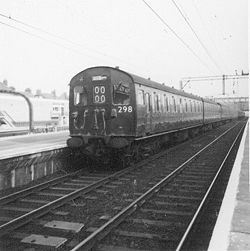| British Rail Class 302 | |
|---|---|
 Class 302 at Barking in 1964 | |
| In service | 1958–1998[1] |
| Manufacturer | British Rail |
| Order no. |
|
| Built at | |
| Family name | BR First Generation EMU |
| Constructed | 1958–1959[1] |
| Refurbishment |
|
| Formation |
|
| Diagram | As built
TOPS Codes As built
Refreshed 1982-84
Refurbished 1983-4
Ex Class 504
Parcels
|
| Design code | AM2[2] |
| Fleet numbers |
|
| Capacity |
|
| Operator(s) | |
| Depot(s) | |
| Line(s) served | |
| Specifications | |
| Train length | 266 ft 7 in (81.25 m) |
| Car length |
|
| Width | 9 ft 3 in (2.82 m) |
| Height | 12 ft 7 in (3.84 m) |
| Floor height | 3 ft 9 in (1.14 m) |
| Maximum speed | 75 mph (121 km/h)[12] |
| Weight |
|
| Traction motors | 4 × English Electric EE536A[8] |
| Power output | 4 × 192 hp (143 kW)[8] |
| Electric system(s) | Originally = 6.25 / 25kV ac Overhead[13] |
| Current collection method | Pantograph |
| UIC classification | 2′2′+Bo′Bo′+2′2′+2′2′ |
| Braking system(s) | Air (EP/Auto)[2] |
| Safety system(s) | AWS[11] |
| Coupling system |
|
| Multiple working | Within class, and other pre-1972 25kV EMUs |
| Track gauge | 1,435 mm (4 ft 8 1⁄2 in) standard gauge |
The British Rail Class 302 (pre-TOPS AM2) was a type of electric multiple unit (EMU) introduced between 1958 - 1960 for outer suburban passenger services on the London, Tilbury and Southend Railway route. This class of multiple unit was constructed using the Mark 1 bodyshell and was slam door.
- ↑ 1.0 1.1 1.2 1.3 1.4 Longworth, Hugh (2015). British Railways Electric Multiple Units to 1975. Addlestone: OPC. pp. 125–127, 154–155, 173–176. ISBN 9780860936688.
- ↑ 2.0 2.1 2.2 Marsden, Colin (1982). Motive power recognition:2. Shepperton: Ian Allan. p. 8. ISBN 0711011656.
- ↑ 3.0 3.1 Swain, Alec (1990). British Rail Fleet Survey 11. Shepperton: Ian Allan. pp. 31–32. ISBN 9780711019027.
- ↑ 4.0 4.1 4.2 Wood, Roger (1989). British Rail Motive Power Combined Volume 1989. Shepperton: Ian Allan. pp. 75–76. ISBN 0-7110-1849-9.
- ↑ Mallaband, Peter; Bowles, L.J. (1978). Coaching Stock of British Railways 1978. Rugeley: RCTS. p. 77. ISBN 0-901115-44-4.
- ↑ Bowles, L.J.; Mallaband, Peter (October 1983). British Rail Coaching Stock 1983/4 (8th ed.). Shepperton: Ian Allan. p. 101. ISBN 0-7110-1352-7.
- ↑ Fox, Peter (1992). British Railways Locomotives & Coaching Stock 1992. Sheffield: Platform 5 Publishing. p. 218. ISBN 1-872524-37-0.
- ↑ 8.0 8.1 8.2 8.3 Wood 1989, p. 76
- ↑ Fox, Peter (1998). British Railways Locomotives & Coaching Stock 1998. Sheffield: Platform 5 Publishing. pp. 240, 355. ISBN 1-902336-00-3.
- ↑ Fox, Peter (1985). Locomotives & Coaching Stock 1985. Sheffield: Platform 5. pp. 158–159, 236. ISBN 9780906579459.
- ↑ 11.0 11.1 11.2 "Vehicle Diagram Book No.210 for Electrical Multiple Units (including A.P.T.)" (PDF). BRB Residuary Ltd. ED205, EE205, EF201, EH302. Archived from the original (PDF) on 3 March 2016. Retrieved 10 May 2021 – via Barrowmore MRG.
- ↑ Wood 1989, p. 75
- ↑ Mallaband, Peter; Bowles, L.J. (1974). The Coaching Stock of British Railways 1974. Kenilworth: RCTS. p. 111. ISBN 0-901115-27-4. LCCN 75330480. OCLC 1974473.
